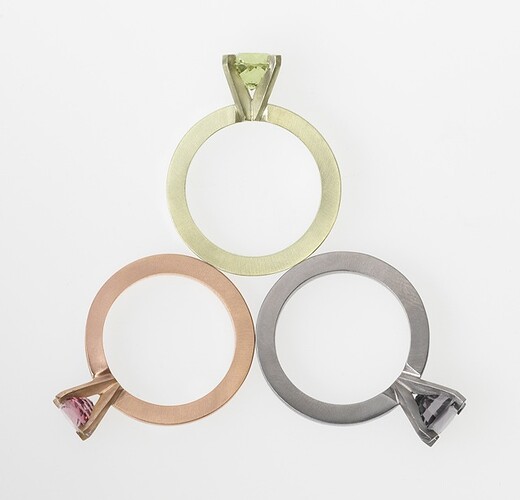Materials: 14K Green Gold & Mali Garnet, 18K Palladium White Gold & Grey Spinel, 20K Pink Gold & Padparadsha Sapphire
Dimensions: Ring shank outer diameter 23mm, setting heights 12-15mm
Each monochrome ring is intended enforce the character of that particular hue, and can be worn individually. When stacked and worn together the colors can complement each other by their comparison.
complement by comparison
Photo credit: SHOOTART, Christopher Burke Studios
Michele Piza
Jersey City, New Jersey. USA
Although my professional experience is not in the jewelry industry, my love of materials, design, craft and beauty eventually lead to me to the 92nd Street Y, where I have been a student for 10 years. I am currently studying with Klaus Burgel. As an aspiring jeweler, I wish to explore the nature of materials, both intrinsically and visually, and to gain confidence in the craft, while I seek my voice as an artist.
The initial inspiration for this piece began with a class project to make a classic Tiffany style diamond solitaire ring. I was more taken with the forms of the shank and prongs in the beginning stages, before they were tapered, rounded and refined, and elected instead to make those forms heavier and stronger still. By giving the metal more weight, I was attempting to give it more presence and equal importance to the stone, instead of the traditional role of showcasing the stone.
But the ring still just felt like strong shoulders for the gem to sit on. Color was the missing factor. Only after giving the color of the metal equal consideration to the color of the stone did they become unified. Each stone and each metal were chosen for how the colors worked together. In the case of these monochromatic rings, neither the stone nor the metal forms are the focal point, but work as a whole.
The exhibition explores metal works whose primary theme is color embraced as their primary visual focus, whether that be using colored materials, exploring creating colored surfaces, or encasing the object in color.
As the world's largest jewelry related internet site, Ganoksin strives to develop exhibitions showcasing work from around the world. This exhibition was open to all metalsmiths, professional and amateur, advanced and beginner.
In total 303 artists contributed 814 show pieces for the permanent online exhibition.
The exhibition was curated by Beth Wicker, President of the North Carolina Society of Goldsmiths in the United States, and Adjunct Instructor at Northeastern Technical College in South Carolina. Director of the exhibition is Hanuman Aspler, founder of The Ganoksin Project, the world's largest internet jewelry site.
Hue is one of the primary properties of color, it refers to the place the color occupies on the visual spectrum. Humans have used hues throughout time, to create cave paintings, to decorate themselves, their clothing and their housing.
Different hues have taken on different meanings throughout time. Gold traditionally has been a color of purity - the metal gold is relatively unchangeable, and the hue of gold has come to stand for gods and goddesses, for royalty, for durability and for purity. Red has often meant love, or passion. Hues often reflect the meaning of the seasons, with pastels referring to spring and the burst of new life after the pale hues of winter. Summer is reflected in vibrant, deep hues, followed by the browning of hues in the fall as plants go to seed and die, and the land turns fallow.
The worth of a hue has often been tied to what is necessary to make the pigment that creates the hue, and the expensive involved in the process. Often created from crushed stones that had to be mined and carried by caravan over thousands of miles, or from fermented roots of plants only grown in certain areas, or the carapaces of rare insects - the creation of hue in a way that could be used by man was an involved and generally expensive process.
In today's world metalsmiths have access to perhaps the widest range of materials and hues in the history of man - and in some of the most affordable ways ever.
This exhibition celebrates hue - color - as an integral, inherent element of the work. We talk of the "richness" of color, and examples of this abound here. One expects hues from the colors of gemstones used in metalsmithing, but we also have hues from some less expected places. Glass enamels are an ancient way of adding color, as are a variety of patinas. Today's artists also use synthetic man-made materials to add color in ways that didn't exist a century ago.
We invite you to enjoy this celebration of hue, and the ways hues and their use have changed over time.
